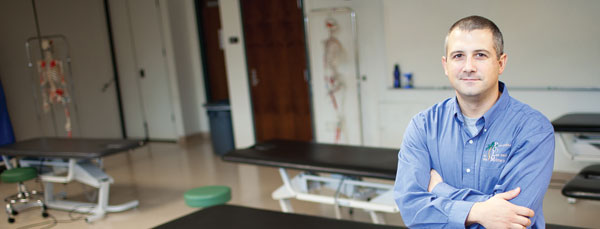Extracts

Education helps soldiers battle back pain
By Jill Pease
A program of core-strengthening exercises was no better than traditional sit-ups for preventing back pain in soldiers, according to a new University of Florida study. But combining exercise programs with a brief educational session on back pain management did lower the incidence of treatment for back pain.
“It was our hypothesis that the core stabilization exercises would have some protective effect for back pain and maybe the combination of the core stabilization exercises and the education program would be the most effective, but as it turns out, adding the education to either of the exercise programs was the only place where we saw the benefit,” said lead investigator Steven George, an associate professor in the UF College of Public Health and Health Professions’ Department of Physical Therapy.
Low back pain is among the most frequent causes of medical visits and lost-duty time in the Military Health System, said co-investigator Lt. Col. John Childs, director of musculoskeletal research at Keesler Air Force Base.
Core exercises target several muscle groups that support the spine, including abdominal muscles, back muscles, side muscles and muscles that attach to the pelvis. The military typically uses traditional lumbar training, which exercises only the abdominal muscles through sit-ups and crunches, George said.
“Core stabilization exercises are considered to be a more balanced approach to lumbar training so that’s why we and others have thought that core exercises would be better at preventing back pain and that may be, but it just wasn’t the case in this study,” George said.
The Prevention of Low Back Pain in the Military, or POLM, study involved 4,325 U.S. Army soldiers stationed at Fort Sam Houston in Texas who were completing a program for combat medic training. Participants were randomized by company into one of four treatment groups of exercises alone, or exercises paired with educational sessions.
The exercise programs were completed as a group under the supervision of a drill instructor once a day, five days a week for 12 weeks. The education program consisted of one 45-minute group session led by study personnel that provided information on low back pain and strategies for recovering from mild back injury.
“Part of the education is just to get people to understand the difference between when pain indicates true injury, which is usually only in the very early stages, and when pain is just a lingering signal, but you can still be active,” George said. “We need to get people moving even when they’re in pain because if we wait until they’re pain-free they can become out of shape.”
The researchers tracked participants’ incidence of low back pain for two years following the intervention using a military health care utilization database. There was no difference in health care visits for back pain in the treatment groups who received exercises only, but among the groups who also received the education program, there was a 3-percent decrease in seeking health care for low back pain.
The decrease may seem small, researchers say, but because back pain is such a common health issue in the military, even a small decrease could lessen the burden on the health care system.